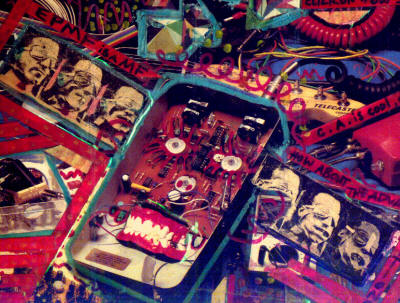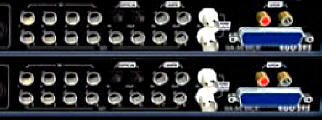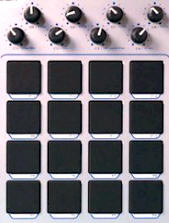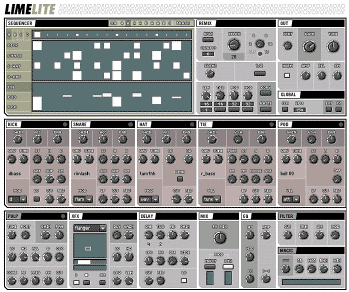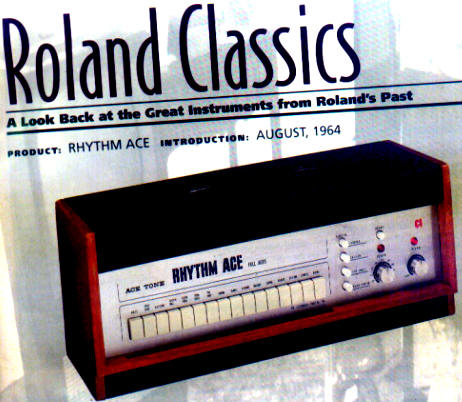yeah i dig the old 16 pad concept, with 8 knobs. i'm rigging me up a new reaktor computer, i'm going to put in 2 wamiracks, i used to use one. they have 4 in 8 out, each one is a 24 bit analog to digital studio grade i/o. ok, now picture 2 of those, so its 8 mic pre amps in, and a 16 bus output! this is a standard possibility in ASIO, see ableton ASIO menu. what does this mean musically? it means you can record and each pad on the trigger finger records to its own discrete track, or instrument, or group of instruments. this means you can totally alter any aspect of the drums, you can make loops with 16 seperate tracks, instead of just stereo. all you have to do is first configure ASIO to give you 16 audio outs, on 16 seperate midi channels, all isolated to a single midi port, for drums only! actually, if you hook this shit up, ASIO will configure to it automatically, because it already is that way, people usually only have 2 or 4 inputs and outputs on their hardware. abelton can send out 16 seperate signals real easy, if you have enough jacks on your i/o box.
this 16 buss audio output gives you the perfect routing to record a basic 16-piece drum set, which ain't bad at all! all you'd really need is a second pass as seperate 16-piece hand percussion setup (or do the percussion first, then the drum set), switch back and forth as you record different sections on up to 16 tracks in one pass. you can also make patterns on the drum machine, then record that midi into the sequencer, then disable the "clock in" at the drum machine, and have the sequencer play the drumbox as a sound module. by this method, you don't have to chain together patterns in the drumbox to parallel the sequencer, a major slow down to the process when the arrangement gets out of sync, which it almost always does. if you want, write a beat into the drumbox, write variations of that beat onto seperate patterns. make about 10 of them. play them back and switch patterns by hand as you go, use your ears, and mute buttons, dicking with battery as it plays back, all the while recording the battery midi out into the sequencer's midi in. its all controlled at the battery "clock in" switch, sometimes its on, sometimes its off, depending who's the MASTER at that moment. the battery "clock out" switch is always on, the battery "midi in + out" are both always on. the sequencer "clock in + out" are both always on, and the sequencer "midi in + out" are both always on. midi thru is off on both battery and the sequencer. to summarize, every clock and midi in/out is on, on both battery and the sequencer. there are only two exceptions. the battery "clock in" switch controls which clock is the master. the trigger finger pads and knobs will always output, no matter what. because all clock and midi THRU's are always OFF, on both sides, this is a one switch solution that will never experience "midi lock", no matter where you press play, no matter where you press record. midi lock during playback is bad enough, it crashes both programs and requires a power down to unlock. but initiating record, and then going immediately into midi lock almost guarantees you just mutilated what you already recorded. this is a big drag!!!!! the only time you would turn a THRU on is if its going out to a midi device with no OUTPUT at all, only INPUT and THRU, to the next INPUT with no OUTPUT, i. e. a "midi DEAD END". keep all thru's OFF, and control the signal flow at the CLOCK IN switch of the SLAVE device.
keep each drum/perc setup midi on its own isolated midi port, use 16 seperate channels of midi to generate 16 seperate channels of audio, if you double the percussion up to 32 tracks, use a second isolated midi port, for that 2nd percussion setup only! each percussion setup has 16 drumbox pads, playing 16 channels of audio, triggered by 16 midi channels routed thru 1 midi port, to record up to 16 discrete tracks of that drumset ONLY!
reaktor drumset ensembles like limelite do this all the time, they also use 128 degrees of velocity to switch samples, depending on how hard you hit the pads. i expect the trigger finger pads have 16 degrees of velocity, instead of 128, really 8 drums per 16 pads providing 128 things to hit is A HELL OF A SET OF DRUMS! if each of 16 pads had 128 samples to choose from, like limelite from reaktor, that would be over 2,000 sounds available for up to 16 tracks, all controlled by the slightest movement of a finger or the rhythmic twisting of a knob |
